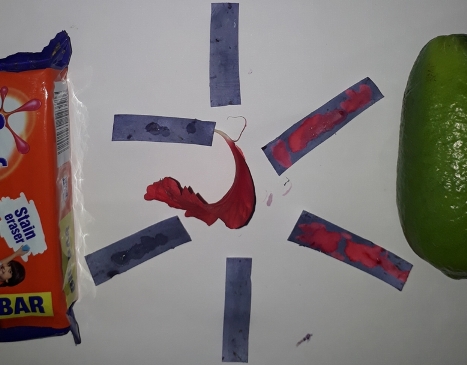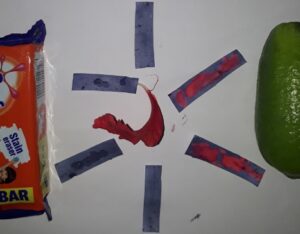LEARNING OBJECTIVES– Knowledge of acids and bases, Knowledge of natural and synthetic acid base indicators, Demonstration of working of indicators, Understanding of neutralization reactions and salt formation, Applications of neutralization reaction in everyday life.
ACIDS–(Gr. Acere= sour) -The taste of acids is sour. They turn the blue litmus paper into red. Their pH (Potential of hydrogen ions) value is below 7. They are corrosive in concentrated form. They conduct electricity.
Those substances which are sour in taste, turn blue litmus into red and have pH value below 7 are called as acids.
Acids are natural as well as synthetic. Natural acids found in plants and animals are called as organic acids. While synthetic acids are called inorganic or mineral acids.
|
TYPE OF ACID |
NAME OF ACID |
SOURCE/FOUND IN |
|
ORGANIC ACIDS |
Acetic acid |
Vinegar |
|
Ascorbic acid (Vitamin C) |
Amla, Citrus fruits |
|
|
Citric acid |
Citrus fruits like oranges, lemons etc. |
|
|
Formic acid /Metheonic acid |
Ant’s sting, bee sting |
|
|
Lactic acid |
Curd |
|
|
Oxalic acid |
Spinach |
|
|
Tartaric acid |
Tamarind, Grapes, Unripe mangoes etc. |
|
|
MINERAL /INORGANIC/ LABORATORY ACIDS |
Nitric acid |
|
|
Sulphuric acid |
|
|
|
Phosphoric acid |
|
|
|
Carbonic acid |
|
BASES– The bases are bitter in taste. Bases feel soapy on touch. They turn red litmus paper into blue. The pH value of bases is more than 7 and upto 14. The liquid forms of bases are called as alkali/ alkaline solution.
|
NAME OF BASE |
FOUND IN |
|
Ammonium hydroxide |
Window cleaner |
|
Calcium hydroxide |
Lime water |
|
Magnesium hydroxide |
Milk of magnesia |
|
Potassium hydroxide |
Soap |
|
Sodium hydroxide |
soap |
NOTE- pH –Scale-:- It is a scale to indicate the strength of an acid, base or salt. It was developed by Sorenson. On it values of these chemicals is between 0-14.
Acids have pH vale between 0-7.
Salts have pH value equal to 7
Bases have pH Value between 7-14.
ACID BASE INDICATORS- Acids are sour and bases are bitter in taste. Salts have no taste. But, it is not safe to taste any chemical substance without knowing it. There are some substances which indicate that the given substance is an acid or a base. Those substances which indicate that the given chemical substance is an acid or a base are called as acid base indicators. There are two categories of acid-base indicators-
A. NATURAL ACID BASE INDICATORS- They are obtained from plants mainly. e.g.-
1. LITMUS: A NATURAL DYE– It is the most common natural acid base indicator. It is extracted from ‘Lichens’ like Roccella tinctoria. Roccella tinctoria has a light purple colour in distilled water but turns red in acidic water and blue in Basic (or alkaline) water.
The Litmus strips are available in red and blue colours. The red litmus strip turns blue when dipped in basic or alkaline solution. It remains red in acidic solution. The blue litmus strip turns red when dipped in acidic solution. It remains blue in basic or alkaline solution.
|
Litmus Strip Colour |
Colour Change on |
|
|
Treatment with Acid |
Treatment with base/Alkali |
|
|
Red Litmus Strip |
Red |
Blue |
|
Blue Litmus strip |
Red |
Blue |
Litmus red and litmus blue solutions also do the same work.
2. TURMERIC– It is yellow in colour. It is obtained from the roots of turmeric plants. Turmeric is used as a spice. It remains yellow on reaction with acids but turns red on reaction with bases. Soaps contain base. Therefore, the cloths on which Sabji (Vegetable Curry) containing turmeric has fallen becomes red on washing with soap.
3. CHINA ROSE (Hibiscus) – The red China rose is especially used as acid base indicators. When petals of it are rubbed on paper strips, the violet colour appears. These violet coloured strips appear pink in colour on treatment with acid. But, remain violet on treatment with base (or alkali).
B. CHEMICAL /SYNTHETIC ACID BASE INDICATOR – These are artificial or synthetic acid base indicators which are prepared in factories.
1. PHENOLPHTHALEIN –It is a synthetic acid-base indicator. It is colourless. It remains colourless in acidic solution while turns basic solution into pink colour.
2. METHYL ORANGE-It is orange coloured synthetic chemical. It becomes pink in acidic solution and become yellow in basic/alkaline solution.
NEUTRALIZATION REACTION AND SALT FORMATION– The reaction an acid reacts with a base to form salt and water is called neutralization reaction. The neutralization reactions are usually exothermic reactions that means heat is released from such reactions.
HCl + Na OH —–> NaCl + H2O + Heat
Where,
HCl = Hydrochloric acid
NaOH = Sodium Hydroxide
NaCl = Sodium Chloride
H2O = Water
SALTS – Salt is generally a solid substance formed as a result of neutralization reaction. They are soluble in water and conduct current in form of solution. Their pH value is 7. Salts can be- acidic salts, basic salts and neutral salts. Their melting point (m. p.) and boiling point (b. p.) are very high.
e.g.- Sodium carbonate- NaCO3,
Magnesium Carbonate- MgSO4,
Potassium Carbonate-KCO3etc.
APPLICATIONS OF NEUTRALIZATION REACTION IN DAILY LIFE-
Following are the applications of neutralization reactions in our daily life-
1. Indigestion– The acid is released in stomach when excess or spicy eating is done. It causes stomachache (pain in stomach) due to acidity. It is neutralized by taking proper amount of antacid. e.g. – Digene tablets and liquid, Gelusil, Ulgel, Diovol etc. like antacids contain magnesium hydroxide (milk of magnesia), aluminium hydroxide like bases.
2. Ant bite– The ant on biting injects formic (Metheonic) acid into the skin. It causes pain. To get the relief baking soda (or Sodium bicarbonate/NaHCO3/ Sodium Hydrogen Carbonate) is applied on the bite area. Also, Calamine solution can be applied to that place as it contains zinc carbonate. The effect of acid is neutralized.
3. Soil Treatment– The plants grow well in slight acidic, neutral or slight basic soil. Excess and continuous uses of chemical fertilizers make the soil too acidic. To neutralize the acidic soil quicklime (CaO- Calcium oxide) or Slaked lime – (CaOH)2 is used. If the soil is too basic, compost (organic matter) is used which releases acid to neutralize basic soil.
4. Factory waste – The factory waste effluents contain acidic substances. They harm the soil and aquatic organisms. So, to neutralize the affects of factory waste, basic substance like quicklime is added.
SOLVED EXERCISE QUESTIONS-
Q.1 State the differences between acids and bases.
Ans-
|
S.N. |
Acids |
Bases |
|
1 |
They are sour in taste. |
They are biter in taste. |
|
2 |
Their pH value is between 0-7. |
Their pH value is between 7-14. |
|
3 |
They turn red litmus into blue colour. |
They turn blue litmus into red colour. |
|
4 |
Acids are found in curd, Vinegar, Amla, Citrus fruit etc. |
Bases are found in soap, windows cleaner, Lime water, Antacids etc |
Q.2 Ammonia is found in many household products, such as window cleaner. It turns red litmus blue. What is its nature?
Ans- Liquid Ammonia (NH3) used as window cleaner is basic (alkaline) in nature.
Q.3 Name the source from which litmus solution is obtained. What is the use of this solution?
Ans- Litmus is extracted from ‘Lichens’ like Roccella tinctoria. The litmus solutions are used as acid base indicator.
Q.4 Is the distilled water acidic/basic/neutral? How would you verify it?


5 following COH IUI with comparative cumulative live birth rates within four cycles of COH and IUI 70 cialis generic but until you know whats really needed and what s being sold to you or diagnosed and rx to you educate yourself on all the drug s entertained, never read the inserts and learn to fix urself